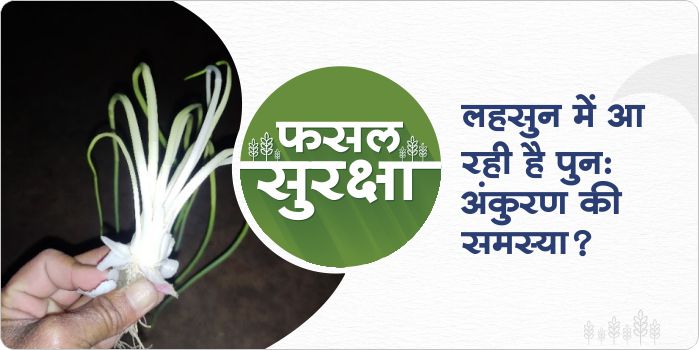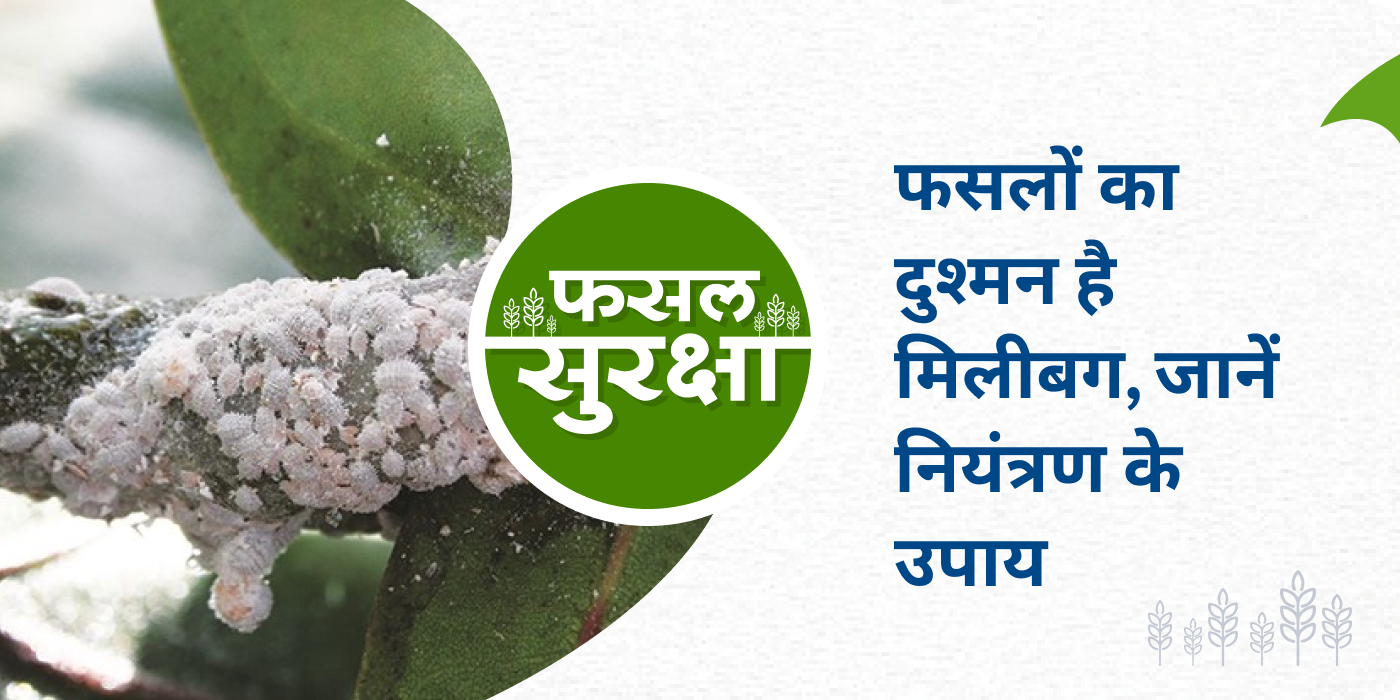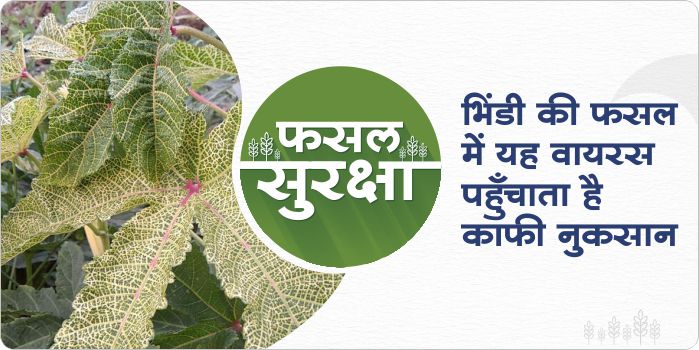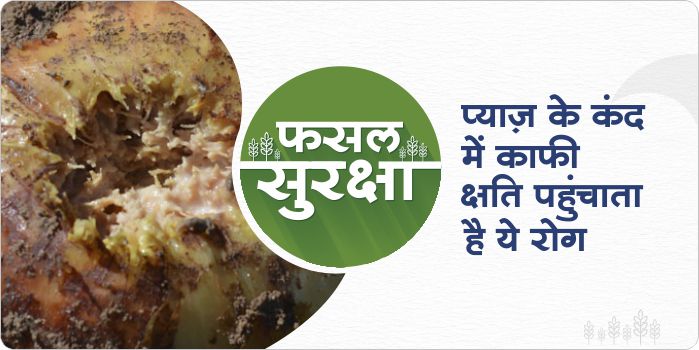Skip to content
- The problem of re-germination in garlic crops is being observed nowadays.
- This problem is caused by over-irrigation and irregular irrigation.
- This problem is also seen in garlic crops due to excessive use of nitrogenous fertilizers.
- To prevent this, Boron @ 20% @ 200 gram/acre + 00:00:50 @ 1 kg/acre.
- Spray paclobutrazol 23% WW @ 50 ml / acre 15 days before harvesting garlic.
Share
- Mealybug is a type of sucking insect which invades leaves or twigs and sucks their sap.
- This insect is like white cottony appearance . adult of the insect that affects the growth or development of the crop or plant by sucking the necessary nutrients from the plant in large numbers.
- To control this pest use Thiamethoxam @ 12.6% + Lambda Cyhalothrin 9.5% ZC @ 80 ml/acre or Fipronil 40% + Imidacloprid 40% WG @ 200 gram/acre
- UseBeauveria Bassiana @ 250gram/acre as a biological treatment.
Share
- Rhizobium bacteria is found in the roots of moong plants which causes atmospheric nitrogen fixation and increases crop yield.
- Use of Rhizobium culture produces fast nodules in pulses, which increases 20-30 % yield of Moong, Gram, Pigeonpea and Urad and 50-60% increases soybean yield.
- The use of Rhizobium culture increases about 30-40 kg of nitrogen per hectare in the land.
- Seed treatment in moong is done with 5-10 gram of Rhizobium culture while the Soil treatment is done by mixing 1 kg / acre for pre-sowing with 50 kg FYM.
- The nitrogen deposited by Rhizobium bacteria present in the roots of the pulse crop is used in the next crop, which reduces the need of nitrogen in the next crop.
Share

- Soil testing can accurately detect the elements present in the soil. After their information, the available nutrients in the soil are found and accordingly the quantity of manure and fertilizer is recommended.
- That is, after soil testing, by giving a balanced amount of fertilizer, more benefit can be taken in farming and fertilizer cost can be reduced.
- Soil testing can detect soil pH, dissolved conductivity, organic carbon as well as major nutrients and micronutrients.
- The normal, acidic or alkaline nature of soil can be ascertained from soil pH value. Soil pH decreasing or increasing affects the growth of plants.
- Soil pH After finding out, suitable crop varieties are recommended in problem prone areas which have the ability to tolerate acidification and alkalinity.
- Soil pH between values 6.5 to 7.5 Nutrients are most commonly consumed by plants, and lime for acidic soil and gypsum for alkaline soil is recommended.
- Electrical conductivity can be known by soil testing, this gives information about the level of concentration or quantity of salts in the soil.
- Due to high concentration of salts in the soil, there is difficulty in absorption of nutrients by the plants.
- Soil testing can determine the fertility of the soil by testing organic carbon.
- The physical properties of soil such as soil structure, water holding capacity, etc. are increased by organic carbon.
- Organic carbon also prevents the leaching of nutrients.
- In addition, organic carbon is also very useful for the availability, transfer and conversion of nutrients and growth of microorganisms.
- Depending on the fertility of the soil, it helps to implement agricultural production and other useful schemes.
- Therefore, all these information shows how important soil testing is.
Share
| Crop |
Lowest Price |
Maximum Price |
| Dollar gram |
3500 |
6795 |
| Wheat |
1501 |
2061 |
| Gram Seasonal |
3800 |
5300 |
| Soybean |
2100 |
5095 |
| Corn |
1200 |
1365 |
| Lentil |
5150 |
5180 |
| Mung bean |
6650 |
6650 |
| Urad |
4005 |
5250 |
| Batla |
3805 |
3905 |
| Toor |
5955 |
6805 |
| Chili |
5000 |
13700 |
Share
- Yellow vein mosaic is a major viral disease caused in okra.
- It spreads due to white fly and causes 25-30% damage.
- The symptoms of this disease are seen in all the stages of the plant.
- Due to this, the veins of the leaves become yellow and a mesh-like structure is formed on the leaves.
- To prevent this,use Acetamiprid 20% SP @ 100 gram/acre or Diafenthiuron 50 % WP @ 250 gram/acre or pyripoxifan 10% + Bifenthrin 10% EC @ 300 ml/acre
- Use Beauveria Bassiana @ 250gram/acre as a biological treatment.
Share
- If the grain size and brightness is good in a wheat crop, then the market price of that crop is very good.
- At the time of filling the grain in wheat, use 00:00:50 @ 1 kg/acre along with Propiconazole @ 25% EC @ 200 ml/acre .
- By using these products, along with the shining in the grains of wheat, the crop is protected from fungal diseases and the nutritional requirement is also fulfilled.
Share
- After harvesting, the most important job is to store grain.
- There is a need to adopt scientific method for safe storage of grains,
- By which grains can be stored for a long time.
- Insects that attack in storage grains are as follows: Small grain borer, Khapra beetle, red beetle of flour, pulses beetle, grain fly, rice moth etc.
- All these pests eat grains and become hollow during storage.
- To keep the grains safe from these pests, First clean the storage house and store it
- Dry grain and store it well.
Share
- Zinc solubilizing bacteria is the most important bacterial culture
- It provides a soluble form of zinc to the plant from insoluble zinc that is present in soil. It is one of the most important micronutrients for plant growth.
- It can also be used as soil treatment, seed treatment, and spraying.
- For soil treatment, use 1 kg/acre mix with 50-100 kg of cow dung, vermicompost and broadcast it in the field before sowing.
- For seed treatment, use 5-10 gram/kg seed.
- Use 500-1 kg/acre as a spray after sowing.
Share
- This disease is a fungal disease, the highest effect of this disease is seen on the bulb of onion.
- This causes white or pink colored fungus to appear at the base of the bulb.
- This disease causes a lot of damage to the roots along with the onion bulb.
- For the prevention of this disease, Thiophanate Methyl 70% W @ 300 gram/acre or Ketazin 48% EC @ 400 ml/acre to the plant near the roots.
- Pseudomonas fluorescens @ 250 gram/acre near roots as a biological treatment.
Share










